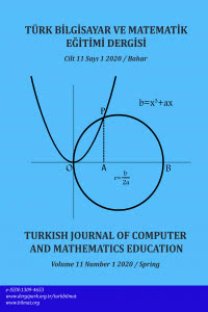Dinamik Matematik Yazılımı Kullanımının Lise Öğrencilerinin Matematik Hakkındaki İnançlarına Etkisi
Bu araştırma dinamik matematik yazılımları ile zenginleştirilen matematik öğrenme ortamının lise öğrencilerinin matematik hakkındaki inançlarında nasıl bir değişim oluşturduğunu belirlemeyi hedeflemiştir. Zayıf deneysel desenlerden, öntest – sontest tek gruplu modele göre yürütülen araştırmada üç alt boyuta sahip daha önce geliştirilmiş bir inanç ölçeğine göre öğrencilerin matematik hakkındaki inançları belirlenmiş ve 20 hafta süren dinamik matematik yazılımı GeoGebra destekli haftalık 2 saatlik seçmeli bir matematik dersinin inançlar üzerindeki etkisi tespit edilmiştir. Buna göre öğrencilerin matematik öğrenme süreci hakkındaki inançları ile ilgili bazı maddelerde olumlu yönde anlamlı değişim gözlemlenmekle birlikte bazı maddelerde de anlamlı olmasa da yine olumlu değişimler tespit edilmiştir. Matematiğin kullanımı ve matematiğin doğası ile ilgili inanç maddelerinde ise anlamlı bir değişim tespit edilmemiştir. Bulgulara bağlı olarak, uygun şartlarda dinamik matematik yazılımı destekli yürütülen matematik derslerinin öğrencilerin matematik hakkındaki inançlarını olumlu düzeyde etkileyebileceği düşünülmüştür.Anahtar Kelimeler: Matematik inançları, dinamik matematik yazılımı, GeoGebra
Anahtar Kelimeler:
Matematik inançları, dinamik matematik yazılımı, GeoGebra
The Effect of Dynamic Mathematics Software to the High School Students’ Beliefs about Mathematics
This research aimed to determine how the beliefs of high school students about mathematics changed in the environment enriched by dynamic mathematics software. The research was designed according to the pretest-posttest single group model which is one of the weak experimental research designs. The beliefs were determined by a belief scale which has three sub-dimensions before and after a 20 weeks elective mathematics course supported by the dynamic mathematics software GeoGebra. After the course, while some items about mathematics learning processes has been positively changed significantly some of the items showed a positive change even if it is not significant. A significant change, about nature of mathematics and usage of mathematics, could not be determined. According to these findings, it is thought that mathematics courses conducted by dynamic mathematics software have the potential of affecting the mathematical beliefs positively.Key Words: Beliefs about mathematics, dynamic mathematics software, GeoGebra
___
- Dweck, C.S. ve Legget, E.L. (1988). A Social-Cognitive Approach to Motivation and Personality. Psychological Review, 95, 256-273.
- Dweck, C.S. ve Bempechat, J. (1983). Children’s theories of intelligence: Consequences for Learning. In S.G Paris, G.M.Olson ve H.W. Stevenson (Eds.), Learning and Motivation in the Classroom (239-256)
- Ernest, P. (1989). The impact of beliefs on the teaching of mathematics. In P. Ernest (Ed.), Mathematics Teaching: The State of the Art (pp.249-254). New York: The Falmer Press.
- Haciomeroglu, E.S., Bu, L. Ve Haciomeroglu G. (2010). Inegrating Technology into Mathematics Education Teacher Courses, GeoGebra NA2010, Ithaca College, Ithaca, NY, USA, July 27-28.
- Kabaca, T., Aktümen, M., Aksoy, Y. and Bulut, M. (2010). Introducing the Mathematics Teachers with the Dynamic Mathematics Software GeoGebra in Eurasia Meeting of GeoGebra and Their Views about GeoGebra, Journal of Turkish Computer and Mathematics Education-TURCOMAT, Vol.1 No.2, 148-165
- Kayaaslan, A. (2006). İlköğretim 4. ve 5. Sınıf Öğrencilerinin Matematiğin Doğası ve Matematik Öğretimi Hakkındaki İnançları. Yayımlanmamış Yüksek Lisans Tezi. Gazi Üniversitesi.
- Kutluca, T. ve Zengin, Y. (2011). Matematik Öğretiminde GeoGebra Kullanımı Hakkında Öğrenci Görüşlerinin Değerlendirilmesi, Dicle Üniversitesi Ziya Gökalp Eğitim Fakültesi Dergisi, 17, 160-172.
- Lampert, M. (1990). When the problem is not the question and solution is not the answer: Mathematical knowing and teaching, American Educational Research Journal, 273 29
- Lucangeli, D., Coi, G. ve Bosco, P. (1997). Metacognitive awareness in good and poor math problem solvers. Learning Disabilities Research and Practice, 12, 209-212
- Mason, L. (2003). Highschool Students’ Beliefs about Maths, Mathemaical Problem Solving, and Their Achievement in Maths: A cross-sectional study, Educational Psychology, Vol. 23, No.1 73-85
- Mason, L. ve Scrivanni, L. (2004). Enhancing students’ Mathematical Beliefs: An Intervention Study. Learning and Instruction, 14, 153-176.
- Perry, W. G. (1968). Patterns of Development in Thought and Values of Students in a Liberal Arts College: A Validation of a Scheme. Cambridge. MA: Bureau of Study Counsel. Harward University. (ERIC Document Reproduction Service No. ED 024315) Preiner, J., (2008), Introducing Dynamic Mathematics Software to Mathematics Teachers: The Case of GeoGebra, Dissertation in Mathematics Education, Faculty of Natural Sciences, University of Salzburg, Austria.
- Raymond, A.M. (1997). Inconsistency between a begining elemantary school teacher’s mathematics beliefs amd teaching practice. Journal for Research in Mathematics Education, Vol. 28, No. 5, 550-576.
- Schraw, G.S., Dunkle, M.E. ve Bendixen, L.D. (1995). Cognitive Processes in WellDefined and Ill-Defined Problem Solving. Applied Cognitive Psychology, 9, 523-538.
- Schoenfeld, A.H. (1989). Explorations of students’ mathematical beliefs and behavior. Journal for Research in Mathematics Education, 20, 338-355
- Schoenfeld, A. (1985). Mathematical Problem Solving. Orlando: Academic Press.
- Schommer-Aikins M., Duell, O. K. ve Hutter, R. (2005). Epistemological Beliefs, Mathematical Problem-Solving Beliefs and Academic Performance of Middle School Students, The Elementary School Journal, 105 (3), pp: 289-304.
- Schommer-Aikins M. &. Walker K., (1997). “Epistemological Beliefs And Valuing School: Considerations for College Admissions And Retention”, Research in Higher Education, 38 (2), pp: 173-86.
- Schommer, M., Crouse, A, ve Rhodes, N. (1992). Epistemological Beliefs and Mathematical Text Comprehension: Believing it is simple does not make it so. Journal of Educational Psychology, 84, 435-443
- Schommer, M. (1990). The Effects of Beliefs about The Nature of Knowledge on Comprehension, Journal of Educational Pschology, 82: 498-504.
- Skemp, R. R. (1976). Relational Understanding and Instrumental Understanding. Mathematics Teaching, 20–26.
- Toluk Uçar, Z., Pişkin, M., Akkaş, E. N. ve Taşçı, D. (2010), İlköğretim Öğrencilerinin Matematik, Matematik Öğretmenleri ve Matematikçiler Hakkındaki İnançları, Eğitim ve Bilim, 35(155), 131-144. Ekler
- Uygulamada Yürütülen Etkinlikler Etkinliğin adı Amacı Açıklama Noktadan doğruya Doğrunun noktalardan oluştuğunu fark edilmesini sağlamak Bir sürgü yardımı ile bileşenleri arasında lineer bir ilişki olan bir sıralı ikili (nokta) tanımlanmış ve sürgünün değişimi ile noktanın iz bıraktığı yerin gözlemlenmesi sağlanmıştır. Doğru parçaları ile süsleme Düzlemsel süslemeleri dinamik olarak müdahale ederek değişimin gözlemlenmesini sağlamak Carnot teoreminin görselleştirilmesi Belli şartlara sağlayan teoremin her durumda sağlandığını gözlemlemek Merkez ve çevre açı ölçüleri arasındaki ilişki Merkez açı ile çevre açı ölçüleri arasındaki oranı belirlemek.
- Başlangıç: 2009
- Yayıncı: Türkbilmat Eğitim Hizmetleri
